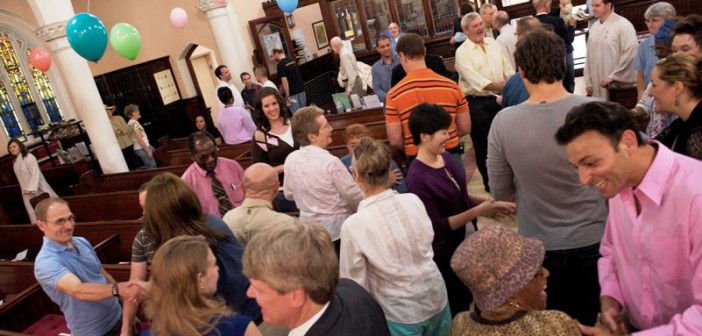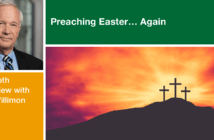I once had a friend who attended church regularly with his wife, but he would wait in the narthex until after the “passing of the peace” portion of the service that occurred near the beginning. “My wife loves it,” he often said, “but that part of the service just does not work for me.” Maybe that’s the kind of person Gail Godwin had in mind in her novel Evensong in which Helen Britt’s husband, Paul, could not stand the passing of the peace. He felt it diverted from worship, and so he used that time to step across the street and buy the Sunday paper. “It was his form of protest,” Helen said.
I thought of these real life and fictional experiences when I read a column by John M. Buchanan, publisher of Christian Century, written after he retired as pastor of Fourth Presbyterian Church in Chicago. He had begun attending other churches and described his experience at two he had recently visited. Acknowledging the history and importance of the practice of passing the peace, nonetheless he says, “I have come to dread this part of the service.”
“All hell breaks loose,” he continues. “People leave their seats, walk around and greet nearly everyone else in the room. Robust conversations ensue. There is laughter, sometimes raucous, as two members share an inside joke. People discuss the results of a football game or yesterday’s storm. As a visitor, I shake the hands of the people immediately around me and then venture tentatively into the aisle.… I’m on my own and not sure what to do. I feel as if I’ve intruded in someone else’s family reunion.”
“The ritual that’s intended to affirm community often does anything but that if you happen to be a visitor. Instead, congregation members are communicating clearly to strangers that their church is a closed corporation.”
I first learned about the ancient practice of passing the peace in seminary. Since then, whenever I have been part of a service that included it, even when practiced poorly, I have kept in mind its place in liturgical tradition. However, Buchanan may be right that in many churches today, it is practiced in ways quite apart from its historical meaning and may even do more harm than good.
Some questions to ask and discuss may help ensure this liturgical practice is still vital in your congregation:
- What is its purpose in our service? Have we communicated that purpose within the congregation?
- Is it currently accomplishing that purpose? Does the pastor think it is accomplishing its purpose? What do worship leaders think about that? What do members of the congregation think?
- What are church members doing during this time? Assign some people to watch for a few Sundays or, better yet, videotape what is happening. Chances are there are multiple patterns going on among the worshipers. What might that tell you?
- What are guests doing during this time? Pay special attention to them.
While the passing of the peace may be a sign of community solidarity, Christian hospitality always gives high priority to welcoming the stranger. As Buchanan puts it, “The hospitality of welcoming the stranger is not only good manners but also Christian spiritual practice. But sometimes a Christian ritual that’s meant to affirm community, love and unity among believers can be exclusive, awkward and off-putting to people who are new or not part of the community.”
So, even if your church does not exhibit the most egregious excesses of bear hugs, ten minutes of nonstop movement, or bone crushing handshakes, you would do well to revisit this tradition that can add to worship or take away from it, depending on how well it is planned and practiced.
Related Resources:
- Ten Best Practice Tips for Hospitality Teams by Fiona Haworth and Jim Ozier
- The First Two Minutes of Worship by Brian Bauknight
- Be the Welcoming Church Video Tool Kit






